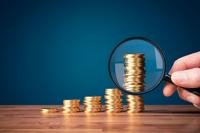Before you take another sip of that $5 latte or buy a new shirt, you need to read this: The average personal savings rate for Americans is at its lowest level since 2001 - it fell to 0 percent in June 2007. What's more the U.S. savings rate is projected to fall below 1 percent at the end of this year, which will qualify as the lowest savings rate since the Great Depression, reports the U.S. Commerce Department.
Financial experts, such as Nancy Register of the Consumer Federation of America, attribute the average personal savings decline to the increase in impulse purchases.
'There's so much marketing pressure to spend and buy and have instant gratification," says Register in a MoneyCentral report. "And if you can't buy it now, you put it on your credit card."
Which begs the question: What are Americans spending most of their money on, that can contribute to such a low average personal savings rate?
According to Bankrate.com, the 10 biggest money drains are the things that you can easily do without. Take a look:
1.) Coffee: The average price of coffee is $1.38 (or more depending on the coffee vendor), reports the National Coffee Association. So, if you buy a 'cup of joe' every morning for a year that could add up to at least $360 a year. That's money that could be contributed to your retirement fund or savings account.
2.) Cigarettes: The average price for a pack of cigarettes in the United States is $4.54. A pack day can cost you about $1,660 a year.
3.) Alcohol: Drink prices vary based on where your watering hole of choice is. However, the average cost of one beer is $5 including tip. Bankrate reports that if you buy two beers a day, it can add up to $3,650 a year. It only gets more expensive if you buy a round of drinks for your friends.
4.) Bottled Water: A liter of bottled water will cost you $1.50. Buying one bottle of water a day will cost you around about $540 a year. This purchase will cost you and the environment in the long run.
5.) Manicures: Nothing is more relaxing than a languorous manicure. But, these types of 'treats' are not economically feasible if you have them done frequently. For example, if you get a $20 weekly manicure, you could cost rob your savings of $1,068 a year. Doing your own manicure will only cost you about $5 ' the price of a bottle of nail polish.
6.) Car washes: The average cost for basic auto detailing is about $58. Not bad, if it's done sporadically. But, if you have your car detailed every two months it will cost you $348 a year.
7.) Buying Your Lunch Everyday: It's hard to get out of the door with all of your belongings, and a sack lunch. But, if you have to buy your lunch everyday, you could be doing serious damage to your savings. For instance, buying your lunch daily will cost you about $9 or $2,350 a year. In short, it pays to spend time to make your lunch.
8.) Vending Machine Snacks - The average vending machine snack is about $1. Buying a pack a day will cost you $260 per year.
9.) Interest Charges on Credit Card Bills - The median credit card debt for most Americans is $6,600. Rate tables on Bankrate.com indicate that fixed interest rates on a standard average is 13.44 percent. If you make the minimum payment each month it will take you 21 years - yes, that's years - to pay off the debt.
10.) Unused Memberships: A gym membership, that goes unused, is probably $40 a month; which can add up to $480 a year. Either use the membership or cut your losses.
If you're diligent and cut back on the extras, such as expensive coffee everyday, you'll be able to contribute more money to your savings account than you expected.
For more information about managing your finances, visit Military.com's Money channel.




